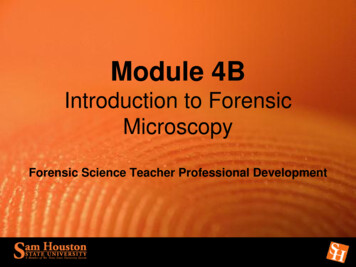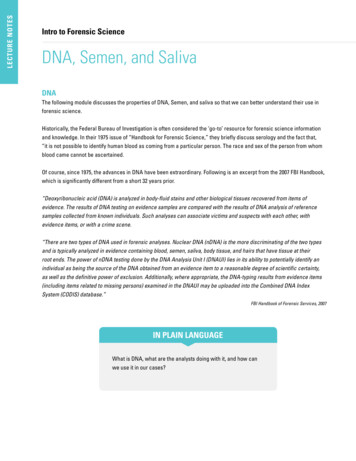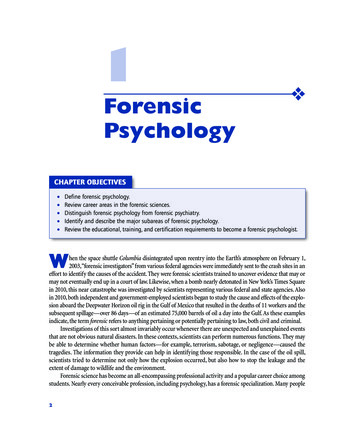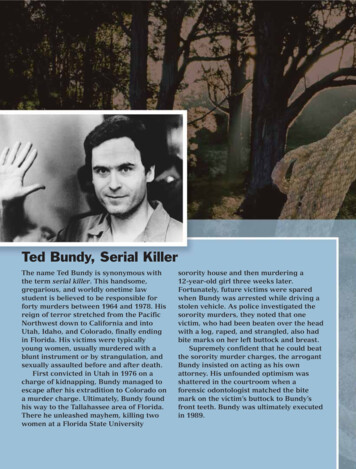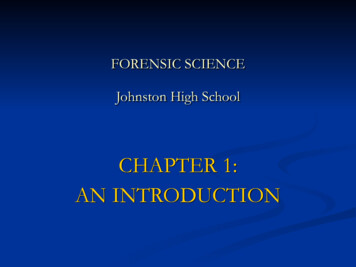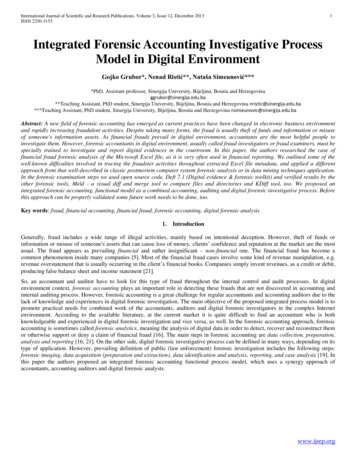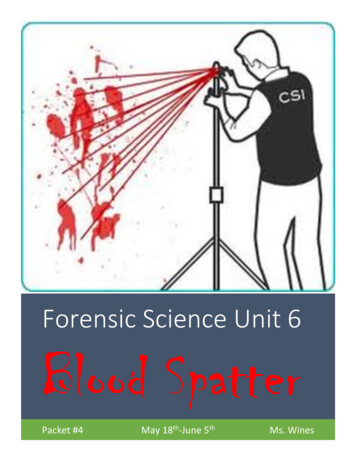
Transcription
Forensic Science Unit 6Blood SpatterPacket #4May 18th-June 5thMs. Wines
Assignments:1. Forensic Files: The Wilson Murder, Analysis Worksheet2. Blood Spatter Notes: Continued3. Crime Case Studiesa. Case Study #1b. Case Study #24. Bloodstain Practice5. Lab #8 Distance Falling v. Surface Texture (Optional)6. Lab #9 Direction of Travel and Angle of Impact7. Three ‘Messy’ Blood Spatter Experiment (Optional)8. Case Study: Unconvincing Circumstantial Evidence; Worksheet9. Blood Detection Notes10. It’s No Use Trying to Hide Blood Worksheet11. Forensic Files: Naked Justice; Questions12. Case Study: Which Neighbor is a Killer? Worksheet13. Case Study: The Death of Tammy’s Parrot Questions14. Bloodstain Pattern Analysis Lab Quiz1
FORENSIC FILES: The Wilson MurderInstructions: Watch Forensic Files The Wilson Murder, and complete the Forensic Files analysisworksheet.https://www.youtube.com/watch?v VXHFSHqwLmQ2
Blood Spatter Notes-ContinuedInstructions: Take NOTES. Notes are available on google classroom under Unit 6-Blood Spatter 2Spatter Pattern and type of Wound Velocity Impact ( ft/sec) –-mist spatter pattern Size of Droplets – less than 1 mm– Ex.-Velocity Impact ( ft/sec)–Size – 1-4 mm–Ex. – , -Velocity Impact ( ft/sec)–Size – 4 to 6 mm– Ex – blunt object impact ( ,, etc)Point of origin Angle of ImpactExamination of Directionality of Blood Shape provides clues to from which blood–drop (width length) – fell straightdown –Typical of dripping (passive)drop (width length) – possible to determine direction blood was3
When blood comes into contact with another surface, it adheres orto it– Point of impact may appear andthan rest of drop of blood spatter– keeps blood moving in direction it was traveling–As droplet moves from source, it and may produce athinner, -like appearance points in direction of blood’s movement or drops may appear inof moving droplet of bloodThis is the TAILANGLE of IMPACT - the angle formed between the of the blooddrop and the plane of the surface it .get angle of droplet from W and L4
Angle of Impact (AOI) Calculations accurately measuring the and of a bloodstain, the impact angle can becalculated using the SIN below:AOI SIN-1 W / L W – Width of blood drop L – Length of blood drop5
Lines of Convergence of source can be determined if thereare at least drops of blood spatter. – found bydrawing straight lines down the long axis of bloodspatter and noting where they view of the location of the sourcePoint of Origin lies at a point in space the point of convergence.o Measurement of the impact angle allows for translation of the 2-D image( ) into a 3-D one ( ).6
1. First measure the from blood stain along its central axis to thePOC (distance y)2. Then take the TAN of the AOI.3. Third, the TAN of the AOI by the .4. Measure that from the floor up the axis and youwill arrive at the Point of Origin (PO)FORMULA: PO TAN (AOI) x y1. Falling directly to floor @ angle will produce circular drops, with secondarysatellites being more produced in the surface hit is textured. – known as a fall.7
2. spurts or gushes typically found on walls or are caused bythe pumping actions of the .3. Splashes are shaped like exclamation points. The shape and position ofthe spatter pattern can help locate the position of the victim at the timeof attack.4. Smears are left by the bleeding victim depositing blood as he or she touches orbrushes against furniture or walls.5. Trails of blood can be left by a bleeding victim as he or shemoves from one location to another. The droplets could beround or smeared or even appear as spurts.6. Pools of blood form around a victim who is bleeding heavily and remains in oneplace.8
9
10
Bloodstain PracticeInstructions: Complete the worksheet1. Calculate the angler of impact for the bloodstains below:11
Below is lab #8 it is not required for you to do, however you may find it enjoyable and this a hands onactivity may give you a better understanding of Blood Spatter Analysis. Encourage a family member tohelp you. Additionally, be innovative on how to complete the lab and creating your own “blood likesubstance.Below are other recipes to create fake blood; especially since the instructions ask for paint and you maynot have paint. This recipe calls for materials you may have in your kitchen.FAKE BLOODYIELD: Makes about 1 cupINGREDIENTS 3/4 cup corn syrup1/4 cup water1/2 teaspoon red food coloring5 drops blue food coloring2 drops green food coloring1 tablespoon corn starchPREPARATIONIn a small bowl, whisk together the corn syrup and water. Add the red, blue, and green food coloringsand whisk until well combined. Whisk in the corn starch and let the liquid sit for 10 minutes to thicken.Realistic Fake BloodThe Spruce Crafts / Rain BlankenFor a realistic look, the blood needs to have more color than pure red. A corn syrup base gives thisrecipe a good thickness, but it is also sticky.Mix Together 2 tbsp Corn syrup 4 drops of red food coloring 1 tsp cocoa mixCOMPLETE LAB #912
13
14
15
The lab below is not required for you to do, however you may find it enjoyable and this a hands onactivity may give you a better understanding of Blood Spatter Analysis. Encourage a family member tohelp you. Additionally, be innovative on how to complete the lab and creating your own “blood likesubstance. There are additional recipes to make fake blood listed on page 11 of this packet.THIS LAB IS MESSY SO COMPLETE IN AN AREA THAT HAS EASY CLEAN UP,AND USE PAPER TO COVER FORPROTECTION. ADDITIONALLY, WEAR ATTIRE THAT IS DARK IN COLOR OR YOU DO NOT MIND STAINING.The conversion for meters to feet is 1 meter 3.28084 feet. If you do not have a protractor you can usethe link provide below to make a paper protractor (for angles do your best and estimate).https://www.google.com/search?q making a protractor&rlz 1C1CHBF enUS895US896&oq making a protractor&aqs chrome.69i57j0l7.7978j0j7&sourceid chrome&ie UTF-8#kpvalbx K227XryMFdLL1QGrp5iQCg3816
17
18
Instructions: Read the following Case Study and complete the worksheet that follows19
20
21
Blood DetectionInstructions: Take NOTES. Notes are available on google classroom under Unit 6-LuminoloUsed to find blood & stains.oin the dark on contact with blood.oThe Luminol test for blood was developed by of Germany in .oLuminol is sensitive in the parts per range even for blood old.Thus, If you have drop of blood in 999,999 drops of , Luminol will glow!!DrawbacksoLuminol up blood during its reaction and thus !oOther popular crime scene materials like and react – Further bloodtesting is a !The glow of fades quickly, but the glow of lasts longer.can tell if they have blood or something else.Phenolphthalein Phenolphthalein is an compound with the formula Physical: White Powder, in water, in alcohol. Chemical: Acid/base indicator, laxative. Human blood pH 7.35 (acid or base?) InpH 8.2-12 ( )* it turns colorless in acidic solutions and pink in basicsolutions.This link shows a Phenolphthalein Test:https://www.youtube.com/watch?v ZvhN9DDm9iIHydrogen peroxide What do you use Hydrogen peroxide on/for?22
Why the bubbles?Leucomalachite greenMalachite green is an organic compound that is used as a dyestuff and controversially as anin aquaculture. Malachite green is traditionally used as a formaterials such as silk, leather, and paper.Below is a link to further describe Leucomalachite greenhttps://www.youtube.com/watch?v 9 fsHnkn02UThis link shows a Leucomalachite green Test:https://www.youtube.com/watch?v HMvmEED5YTMBenzidine Used in making Dyes and blood stains Benzidine has been linked to and cancerBelow is a link to further describe Benzidine:https://www.youtube.com/watch?v z9osQAM9rjkThis link shows a Benzidine Test:https://www.youtube.com/watch?v nWbPhP4OYiMAll of these are presumptive test, meaning the analysis of “a sample to establish one of the following:1. The sample is definitely not a certain substance.2. The sample probably is the substance.For example, the Kastle–Meyer test ‘(Phenolphthalein Test)’ will show either that a sample is not bloodor that the sample is probably blood but may be a less common substance. Further chemical tests areneeded to prove that the substance is blood.Confirmatory tests are the tests required to confirm the analysis. Confirmatory tests cost more thansimpler presumptive tests so presumptive tests are often done to see if confirmatory tests umptive and confirmatory tests23
Instructions: Read and complete the Worksheet-It’s No Use Trying to Hide Blood (pages 23 and 24)24
25
FORENSIC FILES: Naked JusticeInstructions: Watch Forensic Files Naked Justice and answer the following questions.https://www.youtube.com/watch?v kDUdOAzK06U1. What did investigators use to determine how far away the gun was when it was fired?2. Where is the gun usually found when people shoot themselves?3. True or false: The blood in Leann’s palm is consistent with a self inflicted gunshot.4. True or false: People who have just fired a gun should have gunshot residue on their hands.5. True or false: Phenolphthalein is a type of chemical test to identify blood.6. What was found on Mick’s shirt cuff?7. True or false: High velocity blood spatter can be created when a gunshot wound hits an areawith blood and the fine mist of blood blows back toward the gun8. What did investigators use to find where Leann was when she was shot?9. Why couldn’t the wound be self-inflicted?26
Instructions: Read the following Case Study and complete the worksheet that follows27
28
29
30
Instructions: Read the following Case Study and answer the related questions.31
32
33
Forensic Science Unit 6 Blood Spatter Packet #4 May 18th-June 5th Ms. Wines. 1 Assignments: 1. Forensic Files: The Wilson Murder, Analysis Worksheet 2. Blood Spatter Notes: Continu




